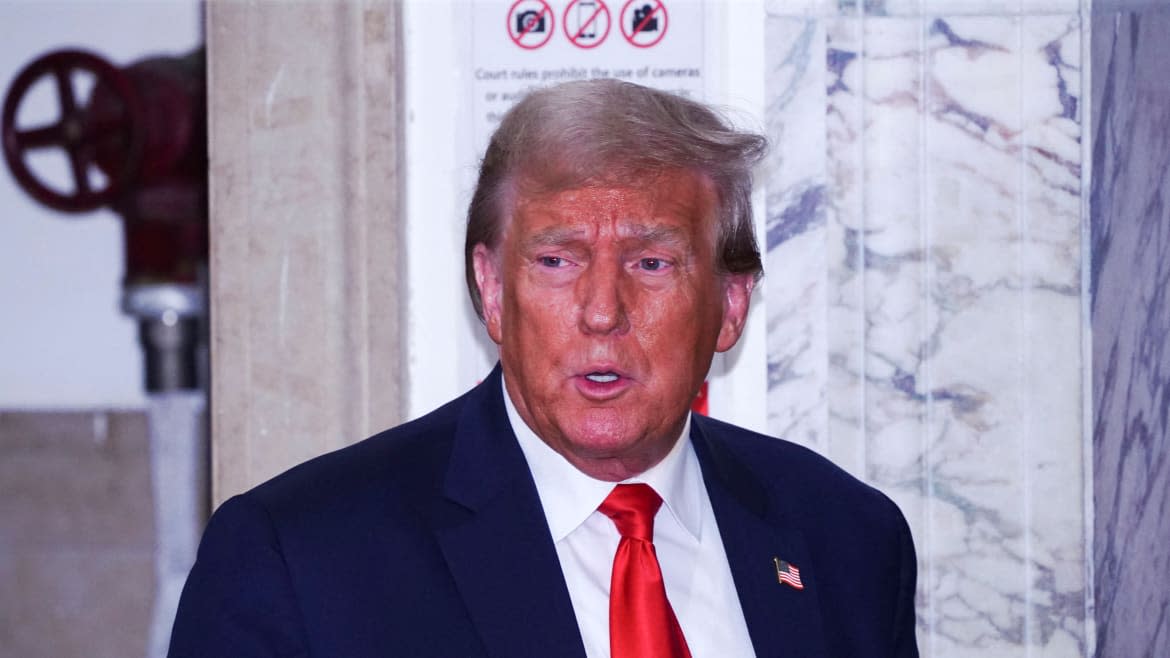Trump’s Lawyers Argue You Can’t Take His Property Values Seriously

- Oops!Something went wrong.Please try again later.
- Oops!Something went wrong.Please try again later.
With the former president sitting in the courtroom, Donald Trump’s lawyers moved into their next phase of attack at his bank fraud trial on Tuesday, arguing that his vastly inflated property values were never official appraisals—and weren’t ever meant to be.
The defense that Trump’s blathering real estate assessments were obviously not to be taken literally was on display Tuesday as his lawyers cross-examined a witness for New York Attorney General Letitia James, who is trying to topple the tycoon’s real estate empire and siphon $250 million or more from his bank accounts.
The tactic centers on the idea that prices are totally relative, and Trump’s guess is as good as any. This doesn’t explain how Trump could blatantly lie about space—like tripling the size of his New York City penthouse on paper. But it is an attempt to undermine the AG’s argument that Trump’s inflated sums weren’t honest or fair.
Trump Tries to Strike Down New York AG Case Before It Starts
During a break in the trial, Trump Organization chief legal officer Alan Garten told The Daily Beast he thinks no assessment of Trump buildings could possibly be grounded in anything concrete—because there’s nothing like them.
"These are unicorn properties,” he said, pointing to Trump Tower. "At 57th and Fifth, you're at the crossroads of the shopping capital of the world. What's the comp real estate? The Champs-Élysées?"
A Trump trial lawyer went further with that idea while questioning the AG’s witness, trying to counter what the AG’s team presented earlier in the day.
The AG’s lawyers spent Tuesday morning questioning Doug Larson, who spent years assessing the overall value of Trump Organization buildings while he worked at Cushman and Wakefield. State investigators used his testimony to show that, after he’d conducted an appraisal, Trump’s staff would fudge the numbers on internal spreadsheets and his personal financial statements.
In one example, assistant attorney general Mark Ladov pointed out how Trump seemed to double count the same commercial space at the Manhattan neo-Gothic skyscraper 40 Wall Street—tallying up the expected income from the Dean and DeLuca grocery store, but then also registering that same area as rentable space that could bring in even more cash.
“Is this double counting the Dean and DeLuca lease?” Ladov asked.
Larson paused and frowned.
“I'm not sure what they did. I know in my June 2015 appraisal, Dean and DeLuca was included in the valuation,” he said.
Ladov also pointed out how the Trump Organization claimed an entirely different—and much rosier—number when assessing the building’s capitalization rate, which measures real estate investments. Generally speaking, a lower number is less risky. Of course Trump made sure the number went down. While Larson quoted a cap rate of 4.25 percent, internal Trump Organization spreadsheets pushed that down to 3.04 percent.
“Is that the same cap rate you used?” Ladov asked.
“No, it is not,” Larson responded.
Trump Shares Article Doxxing NY AG’s Address, May Violate Gag Order
In the afternoon, Florida defense attorney Lazaro P. Fields presented an alternative way to read the situation. His questions drew a distinction between the appraisals and Trump’s statements of financial condition, essentially saying they exist in different universes.
The idea here is that the appraisals were commissioned by Capitol One bank—which was willing to share them with Trump—but the real estate tycoon was free to make his own independent assessments and route them to outside accountants at MazarsUSA to have them compile a snapshot of his wealth.
After all, Garten noted to The Daily Beast, the banks could still rely on their own commissioned study.
But that argument hasn’t been well received by Justice Arthur F. Engoron, who has stressed that the AG does indeed have the power to punish lying entrepreneurs to ensure an honest marketplace—even if no one involved gets harmed by losing money.
Still, Fields pressed Larson to acknowledge that appraisers do official appraisals, while Trump was merely doing valuations—a notion that would free up the tycoon to fill in the blanks as he pleased.
“You agree that appraisals are an art, not a science?” Fields asked.
“I've heard that term before, yes,” Larson said, later acknowledging that two appraisers in the courtroom could come to two different conclusions.
Fields repeatedly pointed out that Cushman and Wakefield’s own appraisal paperwork noted that “the intended function is for loan underwriting and/or credit decisions by Capital One bank and/or participants," obliquely countering a previous AG argument that Trump hid these appraisals from his Mazars accountant.
Fields ended the bank fraud trial’s eleventh day by furthering an argument that is bound to see more play as the court battle moves forward: the idea that coming up with real estate prices is a nebulous endeavor.
He pulled up copies of two appraisals Larson issued on the same date in November 2012, with one pegging 40 Wall Street at $200 million while the other claimed it was $220 million.
“You're not sure which of these two is the final verdict?” he asked.
Fields did it again, pointing to two November 2015 appraisals in which Larson separately assessed the same building at $240 million and $260 million.
“It is possible you made an error appraising this property?” Fields inquired.
“I don't know... it's possible,” Larson said.
Get the Daily Beast's biggest scoops and scandals delivered right to your inbox. Sign up now.
Stay informed and gain unlimited access to the Daily Beast's unmatched reporting. Subscribe now.

